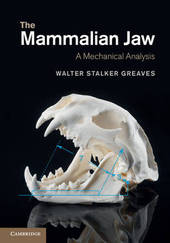
|
The Mammalian Jaw: A Mechanical Analysis
Hardback
Main Details
| Title |
The Mammalian Jaw: A Mechanical Analysis
|
| Authors and Contributors |
By (author) Walter Stalker Greaves
|
| Physical Properties |
| Format:Hardback | | Pages:126 | | Dimensions(mm): Height 254,Width 178 |
|
| Category/Genre | Animal physiology
Mammals |
|---|
| ISBN/Barcode |
9781107016224
|
| Classifications | Dewey:571.53319 |
|---|
| Audience | | Professional & Vocational | |
|---|
| Illustrations |
32 Line drawings, unspecified
|
|
Publishing Details |
| Publisher |
Cambridge University Press
|
| Imprint |
Cambridge University Press
|
| Publication Date |
19 July 2012 |
| Publication Country |
United Kingdom
|
Description
Mammalian skull structure is notably diverse; however at a basic level the jaw mechanism is remarkably similar, if not essentially the same, in the majority of mammals. Using simple models that are compared with real animals at every step, this book examines the basic structural features of the mammalian jaw mechanism from a mechanical point of view. It explores how the mechanical constraints placed on the jaw have contributed to the evolution of an efficient basic structure, used by many mammals, which precludes mechanical difficulties and uses a minimum amount of bone tissue. Throughout the book the emphasis is on conceptual understanding, with explanations linked together to form a complete story that can be applied to both fossil and extant mammals. Summarising over forty years of research from one of the leading pioneers in 3D jaw mechanics, this is a must-have for anyone interested in mammalian jaw morphology.
Author Biography
Walter Stalker Greaves is a retired affiliate of the Department of Oral Biology, University of Illinois, Chicago. He spent his career teaching anatomy at Indiana University of Pennsylvania and human gross anatomy in the College of Dentistry, University of Illinois, Chicago. His research concentrated on the mammalian jaw mechanism, using very simple mechanical models to explain how the jaw works and why the jaw mechanism has evolved to essentially the same basic structure.
|